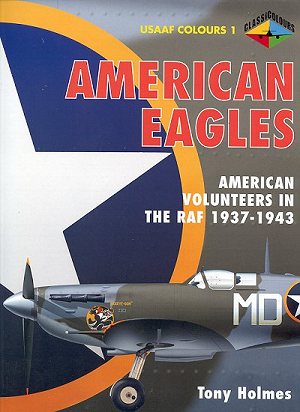|
BOOK: |
American Eagles |
|
BY: |
Tony Holmes |
|
PUBLISHER
/PRICE: |
Classic
Publications, 2001
$23.95 |
|
REVIEW BY: |
Scott
Van Aken |
|
NOTES: |
Artwork by
Mark Styling & Chris Davey |
 In the days before aircraft were so
complicated to fly that it took years to learn, it was not uncommon for
'foreigners' to be flying in the air arms of various nations. This was
especially true when it came to conflicts. Pilots were generally in shorter
supply than aircraft and experienced pilots of all sorts were frequently lured
to warring nations by offers of money or just for the thrill of flying combat.
This was especially true of the Spanish Civil War as well as China's war with
Japan in the late 1930s.
In the days before aircraft were so
complicated to fly that it took years to learn, it was not uncommon for
'foreigners' to be flying in the air arms of various nations. This was
especially true when it came to conflicts. Pilots were generally in shorter
supply than aircraft and experienced pilots of all sorts were frequently lured
to warring nations by offers of money or just for the thrill of flying combat.
This was especially true of the Spanish Civil War as well as China's war with
Japan in the late 1930s.
The RAF of the early war was
particularly one of many nationalities. Not only were there pilots from those
countries over run by the Germans, but also some who sought to help stave the
flow of German aggression. At least, that is what they would have said. I
personally feel that some were there because they liked to fly combat!
This initial book in a series
entitled USAAF Colors, is about Americans who flew with the RAF in the early
years. It was a bit of a surprise to find that there were several 'Yanks' in the
RAF prior to the war. Most of these were wealthy businessmen or sons of such who
were living in the UK. They tended to gravitate to 601 Sq of the Auxiliary Air
Force and it was very much a country club sort of operation.
However, when the war
started, these men were quickly involved in the heat of battle. The book covers
the exploits of these early eagles in detail, since there were so few of them.
It extends through the formation of the Eagle Squadrons in late 1940 until they
were eventually incorporated into the USAAF in late 1943 as the 4th Fighter
Group.
Also part of the book
involves those American units who flew the Spitfire and were integrated into the
various British groups, as was common until the USAAF was able to get sufficient
administrative and logistical forces into the theatre to provide the operational
control needed.
The author has done a fine
job of telling the story, and I found the early years or 1940-41 to be
especially informative and interesting. Interspersed throughout the book are
photos and profiles of aircraft that were flown by the various pilots. In
typical British fashion, a complete operational history in terms of previous and
follow-on units is given for each aircraft photo. This kind of information only
adds to the book and is part of what I find appealing about it. The profile
drawings are crisp and well drawn, though not quite to the level of an
Eddie Creek or Tom Tullis.
Overall, I found the book to
be well done and one that is worth the cover price. I appreciate the large
images and easy to read type-face. There are several other books coming in the
series, but to me, they seem like they will be redundant to what has been
already done by Osprey.
I can easily recommend this
book to those who have an interest in the subject. I am sure that it will spawn
a decal sheet or two, but with the demise of Aeromaster, I'm not sure who will
pick up the ball and run with it.
July 2001
Review copy courtesy of me
and my credit card!
If you would like your product reviewed fairly and quickly by a
site that has over 3,000 visits a day, please contact
me or see other details in the Note to
Contributors.
 In the days before aircraft were so
complicated to fly that it took years to learn, it was not uncommon for
'foreigners' to be flying in the air arms of various nations. This was
especially true when it came to conflicts. Pilots were generally in shorter
supply than aircraft and experienced pilots of all sorts were frequently lured
to warring nations by offers of money or just for the thrill of flying combat.
This was especially true of the Spanish Civil War as well as China's war with
Japan in the late 1930s.
In the days before aircraft were so
complicated to fly that it took years to learn, it was not uncommon for
'foreigners' to be flying in the air arms of various nations. This was
especially true when it came to conflicts. Pilots were generally in shorter
supply than aircraft and experienced pilots of all sorts were frequently lured
to warring nations by offers of money or just for the thrill of flying combat.
This was especially true of the Spanish Civil War as well as China's war with
Japan in the late 1930s.